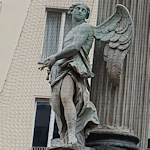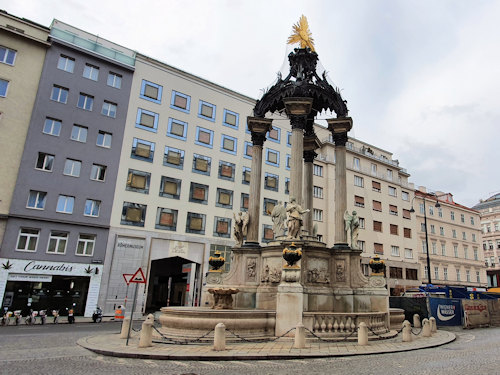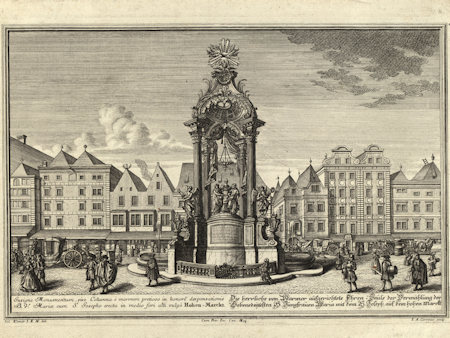
You know the videos where someone stands still and everyone rushes past in high-speed? The Vermählungsbrunnen is the historical equivalent: a seemingly ever-present monument on a square that’s changed considerably through the ages.
- Baroque monument unveiled in 1732
- Dedicated in thanks to Saint Joseph
- Depicts his marriage to the Virgin Mary
- Also appeared in The Third Man
- Book a themed guided tour* of Vienna
- See also:
One wedding & a movie

(The Vermählungsbrunnen in its not-quite-so-old surrounds)
Although the name translates as wedding fountain, the Vermählungsbrunnen is actually a form of votive column: a monument erected in thanksgiving.
Much like the more famous plague column elsewhere in Vienna, this stone monument replaced an earlier version made largely of wood. The motivation for its initial construction goes back to Emperor Leopold I (1640-1705).
Leopold had promised to build the monument in honour of St. Joseph should his son, the future Emperor Joseph I, return safely and successfully from a siege of the stronghold at Landau during the war of the Spanish succession at the start of the 1700s.
The first version appeared in 1707 after Leopold’s death. The more durable update appeared around 25 years later under the aegis of Emperor Charles VI (he of Karlskirche fame, who succeeded his brother, Joseph, in 1711).

(The Vermählungsbrunnen on Hoher Markt around 1733, as illustrated by Salomon Kleiner, engraved by Johann August Corvinus and published by Johann Andreas d. Ä. Pfeffel; collection of the Wien Museum, reproduced with permission under the terms of the CC0 licence)
The monument’s name does actually make sense.
Two small fountains flank the set of columns, for example. And the central scene shows the marriage of Saint Joseph to the Virgin Mary.
That event was a motif popular in much religious art. Raphael famously painted a similar scene in 1504, for example, as did El Greco around 100 years later.
You find the monument on the Hoher Markt square, close to Stephansdom cathedral.
(The 1732 inscription contains a dedication to Joseph and details how Charles VI’s new bronze and marble construction replaces the one put up by his predecessors)
The location belongs to the historical centre of the city, predating the arrival of any Habsburgs by centuries: Roman officers lived on this spot and Emperor Marcus Aurelius may have stayed here. Vienna’s Römermuseum (Roman Museum) actually occupies house no. 3.
Despite its age, the square looks largely modern, for which we can thank the bombs of World War II. Yet the Vermählungsbrunnen remains, like an ancient oak among all those upstart pines.
We actually have a near-literal historical record of how the Hoher Markt looked immediately after the war, since it plays a role in the movie, The Third Man.
The Vermählungsbrunnen appears several times in the film, most notably toward the end as the net closes in on the villainous Harry Lime.
How to find the Vermählungsbrunnen
The monument lies centrally on the river side of the old town.
As well as the Römermuseum, another near neighbour is the Ankeruhr; clusters of tourists wait around this mechanical clock at midday to see the full rotation of its figures (one of which is Marcus Aurelius himself).
Subway: a short walk from the stations Stephansdom (U1 and U3), Herrengasse (U3) or Schottentor (U4 and U1)
Tram/Bus: the 1A and 3A “old town” buses both stop at Hoher Markt.
Address: Hoher Markt, 1010 Vienna
